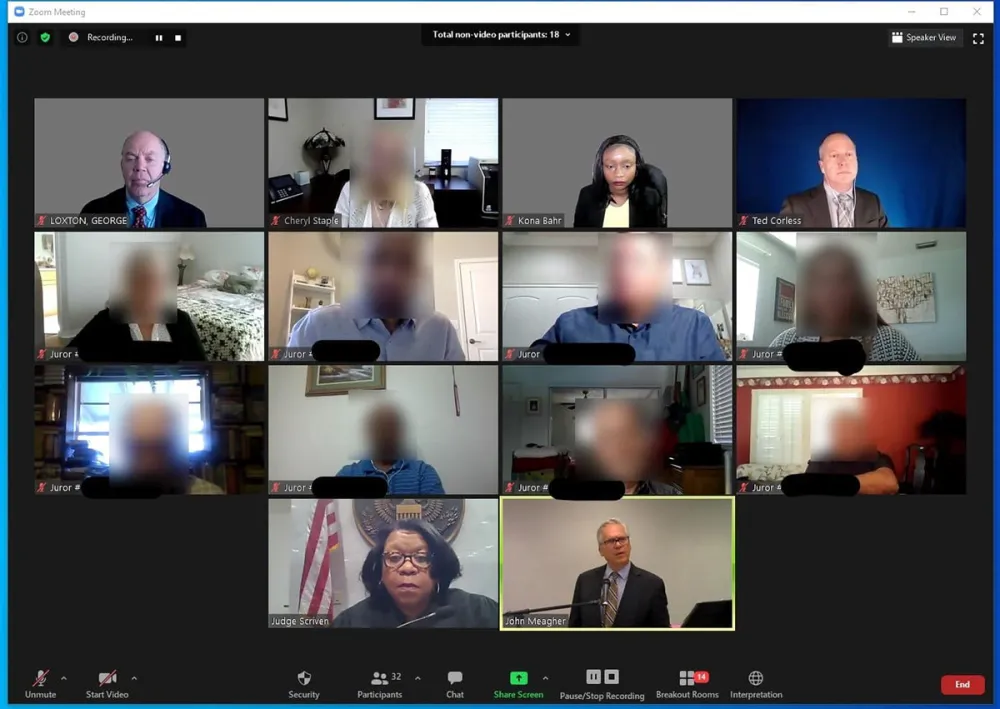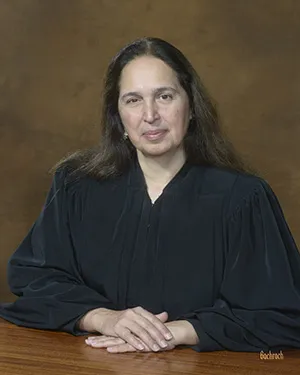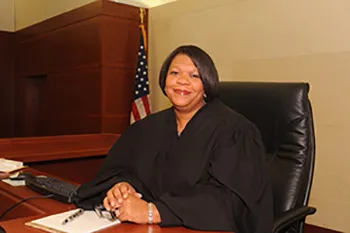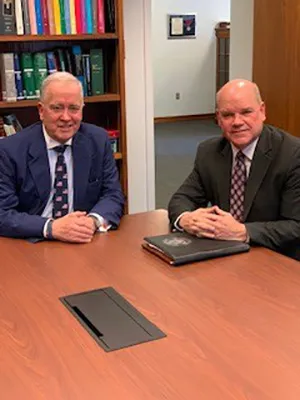
A screenshot shows a recent virtual civil trial conducted by Judge Mary S. Scriven, of the Middle District of Florida. The jurors' faces are obscured.
As she started a civil jury trial in early October, Judge Marsha J. Pechman looked across her federal courtroom in Seattle, Washington. It was completely empty.
The litigants and their lawyers beamed in via video. So did her law clerks, and the court reporter tasked with transcribing the trial. Most strikingly, the eight jurors deciding the case also were participating by video from their homes.
Since the pandemic first closed many courts, one of the most significant adjustments made by federal courts has involved the use of electronic communications. Under provisions of the CARES Act, a COVID-19 relief law passed last March, federal courts began conducting routine procedural hearings, such as first appearances for criminal defendants, by telephone and video hookups.
As the coronavirus (COVID-19) has dragged on, a small number of courts have adapted electronic proceedings to meet more challenging situations. Several courts have conducted virtual bench trials, which do not require a jury. In a few cases, courts holding high-profile hearings have needed to stretch virtual technology to accommodate large numbers of listeners. In perhaps the most ambitious experiment yet, the Western District of Washington recently began holding all-virtual jury trials in civil lawsuits.
“Video jury trials are a tool that can be used, and it’s a tool we need to use unless we are going to be backed up forever and ever,” said Pechman, who has heard four virtual civil jury trials in recent months. “It has worked better than my initial expectations, all the way around. The jurors have been very, very diligent. They’ve cleared themselves of distractions and worked hard to pay attention.”
Electronic proceedings also have shown vulnerabilities. In one of Pechman’s trials, proceedings were suspended when a windstorm cut some jurors’ internet connections. And during a high-profile election case in Pennsylvania, a telephone outage interrupted audience audio.
Overall, however, judges said the virtual proceedings were fair and efficient.
“I think it worked just as well as in person,” said U.S. District Judge Indira Talwani, of the District of Massachusetts, who has conducted two non-jury trials that brought together witnesses from multiple countries. “The convenience of not having to travel here was enormous. Absolutely it was an effective way to deliver justice.”
At least five courts have scheduled virtual civil jury trials, with jurors serving from home. In addition to the Western District of Washington, the Middle District of Florida and the District of Minnesota have conducted virtual civil jury trials. In the Districts of Kansas and Rhode Island, litigants settled their disputes before virtual jury trials began.
“It flowed seamlessly from jury selection through deliberations,” said Judge Mary S. Scriven, of the Middle District of Florida, who presided over a five-day all-video civil trial in late January. “I would do it again in a heartbeat. There were no more glitches than are typically seen in an in-person trial.”
Other courts have adopted a mix of tactics. In the District of Connecticut, jury members in one civil case were selected virtually from home but then came to court for an in-person trial.
The following are examples of how some courts have used electronics to deliver justice in more complex court situations.
Bench Trials in Boston
Bench trials are one of the simplest forms of federal trials because they do not require juries. In addition to deciding questions of law and procedure, the judge also determines the verdict.
But before Judge Indira Talwani conducted two bench trials in late August, her court in Boston had to use an entirely new technical structure to support trials with witnesses testifying from other continents. In one, an international child custody dispute, a parent would be participating from Armenia, while a separate business dispute involved possible witnesses from London and China.

District Judge Indira Talwani, District of Massachusetts
“I issued a protocol of procedures,” Talwani said. “I didn’t want everyone there and not having checked their bandwidth, and things like that. So my courtroom deputy played a critical role in doing a test run with everyone.”
Pretrial conferences also gave participants a chance to test the system. In addition to witnesses, the court had to connect Armenian interpreters into the child-custody case. Because the online video service had a translation function, listeners could choose to follow the trial in English, Armenian, or hear both languages.
The child custody dispute went smoothly, except for one hitch.
“The father who was making his custody claim was sitting with a well-positioned photograph of him and his daughter on the desk. That would not have happened in the courtroom,” Talwani said. “That’s a lesson I’ve learned. The witnesses need to be encouraged to appear as if they were on the witness stand and not think of it as an opportunity to color the proceeding.”
The makeshift virtual format had significant pros and a few cons, Talwani said. On the negative side, litigants can’t see each other in person, but in both cases she heard, the opposing sides knew each other well, reducing that concern.
On the plus side, seeing the full faces of witnesses on a screen 18 inches away, instead of viewing them at an angle in the witness box, provided a better view.
The biggest advantage was convenience for participants.
“For these parties, the difference of not having to travel here was enormous,” Talwani said. “To be able to do all of that without everyone having to spend the travel time worked very well. If people are cost conscious, it would make a huge difference.”
Virtual Civil Trials in Seattle and Florida
A senior judge for the Western District of Washington, Marsha Pechman first conducted a virtual bench trial in June. Her immediate takeaway: “I was stunned by how well it went off.”
When Pechman began to draft a manual for judges and lawyers on virtual bench trials, Chief Judge Richard Martinez asked her to expand her focus to include virtual jury trials, in which jurors would hear the case from home using virtual technology. The request forced her to consider legal and technical questions that literally had no precedent in the federal Judiciary.

Senior Judge Marsha J. Pechman, Western District of Washington
“I had the Ninth Circuit librarians look for case law, and the answer is, there’s nothing out there,” Pechman said. “We only found a few futuristic articles by legal scholars.”
As she and other judges looked more closely, they concluded that while criminal trials probably needed to be conducted in person, because defendants have a constitutional right to confront their accusers, lawyers already were allowed to take civil depositions by video. The court decided that civil jury cases would stand up to any appeals.
Assembling virtual juries raised additional questions. Pechman was especially worried that the requirement to use computer equipment might skew the jury pool, reducing the number of elderly and low-income jurors. The court made provisions to train jurors without computer skills, and to lend computers to those who lacked suitable equipment.
In the four virtual jury trials she has conducted, Pechman was surprised to find that it was easier to assemble diverse juries. For some jurors, not having to travel a hundred miles or more to a federal courthouse was a major advantage.
In one case, a windstorm temporarily knocked out a juror’s connections. But, Pechman noted, in-person trials also experience disruptions, such as jurors getting delayed in traffic. The jurors deliberated virtually, rendering million-dollar-plus verdicts in two cases, and deciding in favor of the defendant in a third. A fourth case ended in a settlement after eight days of trial.
“I debriefed each of the jurors. We asked if you feel like you can pay attention while you’re sitting in your own home. The jurors overwhelmingly said yes,” Pechman said. “I know the lawyers would say this guy was sitting in his laundry room, and this lady was sitting on her bed, but the point is, we invaded their house, and they found the best space they could in order to pay attention.”

Judge Mary S. Scriven, Middle District of Florida
Pechman has shared her experiences and resource materials with other courts. Judge Scriven, of the Middle District of Florida, “only slightly modified” a handbook provided by the Western District of Washington in setting up her trial, an insurance case.
“The jurors commented that they appreciated the ability to see the exhibits and see and hear the witnesses clearly because everything was magnified on the screen,” Scriven said. “We even had a doctor/fact witness appear in full COVID-19 protective gear from the hallway of the hospital where she worked.”
Virtual Media Access in Pennsylvania
Perhaps the greatest stress test of virtual courtroom technology occurred in November, when an election law case in Williamsport, Pennsylvania, attracted national attention.
Under the CARES Act, which was passed by Congress early in the pandemic, federal courts were permitted to conduct most court proceedings by telephone and video hookups. In an unprecedented step, the federal Judiciary ensured the constitutional guarantee of public trials by making call-in lines available to the media and public, not just lawyers and litigants, in almost all federal proceedings.
In routine cases, that has posed little if any strain on federal courts. The Middle District of Pennsylvania, for instance, relied on WebEx technology with a call-in capacity of 200 to 300 listeners. But with the filing of Trump v. Boockvar, which challenged Pennsylvania’s presidential voting results, the court knew it needed more lines, but it wasn’t clear how many.
Concerned that national organizations might circulate online hearing information, potentially flooding the call-in lines and blocking access to some reporters, the court initially boosted its capacity to 4,000 listeners, and then raised it to 8,000 the morning of the hearing.
“This was clearly not a time for half measures. You either go big or go home,” said Chief Judge John E. Jones III.
For more than an hour, the system seemed to hold. Most or all of the 8,000 lines were in use, accommodating a far greater audience than normally could listen in, and the hearing was proceeding without incident. Then an AT&T server failed, plunging the public audio into silence.

Chief Judge John E. Jones III, left, and Clerk of Court Peter J. Welsh, Middle District of Pennsylvania
“It was an unbelievably stressful time,” said Peter J. Welsh, Clerk of Court for the Middle District. “When we realized it wasn’t just a few lines, we called AT&T, and they said they could fix it in five minutes. Five minutes turned to 10, and then 15. We notified the courtroom deputy.”
By the time U.S. District Judge Matthew W. Brann called a recess, the hearing had proceeded 25 minutes without public audio. Once repaired, the AT&T audio performed without incident for the rest of the hearing. The court addressed the audio gap by posting a transcript of the proceeding on its website, and Jones also issued a public statement.
“The transcript went a long way toward cleaning things up,” Jones said. “People wanted to know what they missed and what had happened. They had to have some account of it.”
Even with the audio interruption, Jones believes the public and media benefited from increased access.
“Despite the hiccup of the dropped lines, members of the press thought that on balance, the court did do a good job,” Jones said. “It may have been imperfect, but it was still awfully effective under the circumstances.”
Moving Forward
The long-term role of electronic court proceedings remains unclear. While virtual trials in civil cases remain a rarity, a Feb. 5 how-to seminar hosted by the Western District of Washington attracted more than 900 participants from more than 60 district courts.
Under the CARES Act, the Judiciary will end most electronic proceedings once the pandemic emergency is declared over. Until then, judges agreed in interviews, telephone and virtual hookups will play an important role in moving cases forward.
Read the Series
This is the fifth in a series of articles about how federal courts are working to recover from the COVID-19 crisis.
Chief Judge John R. Tunheim, of the District of Minnesota, said virtual civil trials are likely to be needed even after more people receive vaccinations. That is because anti-COVID-19 measures, such as plexiglass barriers and social distancing, will greatly reduce courtroom capacity, and criminal cases must be tried in person.
“We will only have one courtroom in Minneapolis and one in St. Paul for trials,” Tunheim said, “so the ability to do civil trials virtually while we catch up on our criminal trial backlog will be very helpful.”
And despite inevitable wobbles, judges said virtual strategies have preserved the essentials of justice during the nation’s worst health crisis in a century.
“I have no backlog. Every single case I had set in 2020 got tried in 2020,” Pechman said of her virtual civil jury trials. “I tell my fellow judges this may be the only way the wheels of justice will still turn.”
Jones was pleased that a critical case proceeded without delay, but also without sacrificing public access.
“The best of it was the fact that in the middle of a pandemic, Judge Brann could conduct this massive preceding, that literally had national import, and finish the case in two weeks,” Jones said of the Pennsylvania election lawsuit. “We operated in a way that promoted the Third Branch, and that’s the way it should be.”
Subscribe to News Updates
Subscribe to be notified when the news section is updated.
